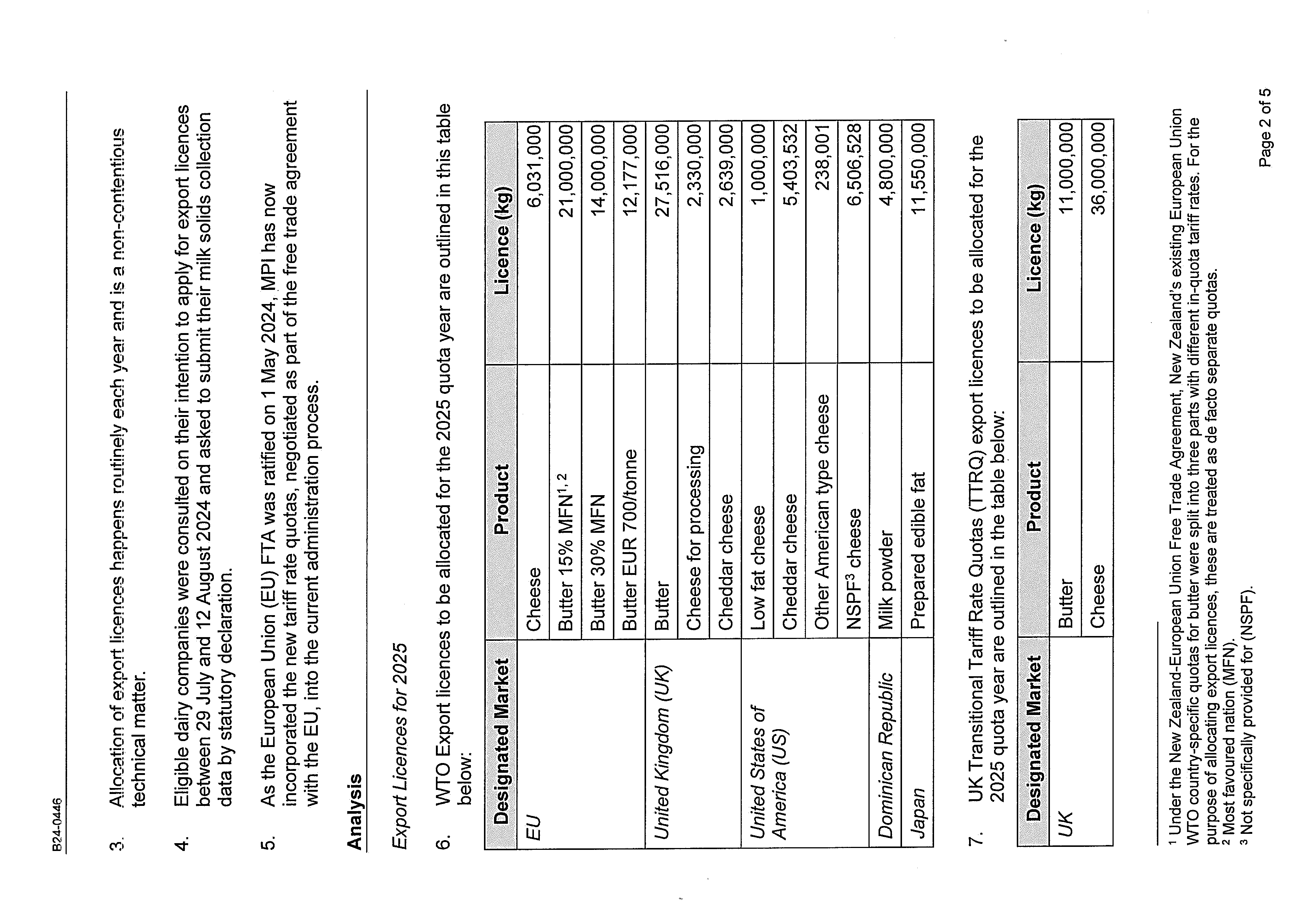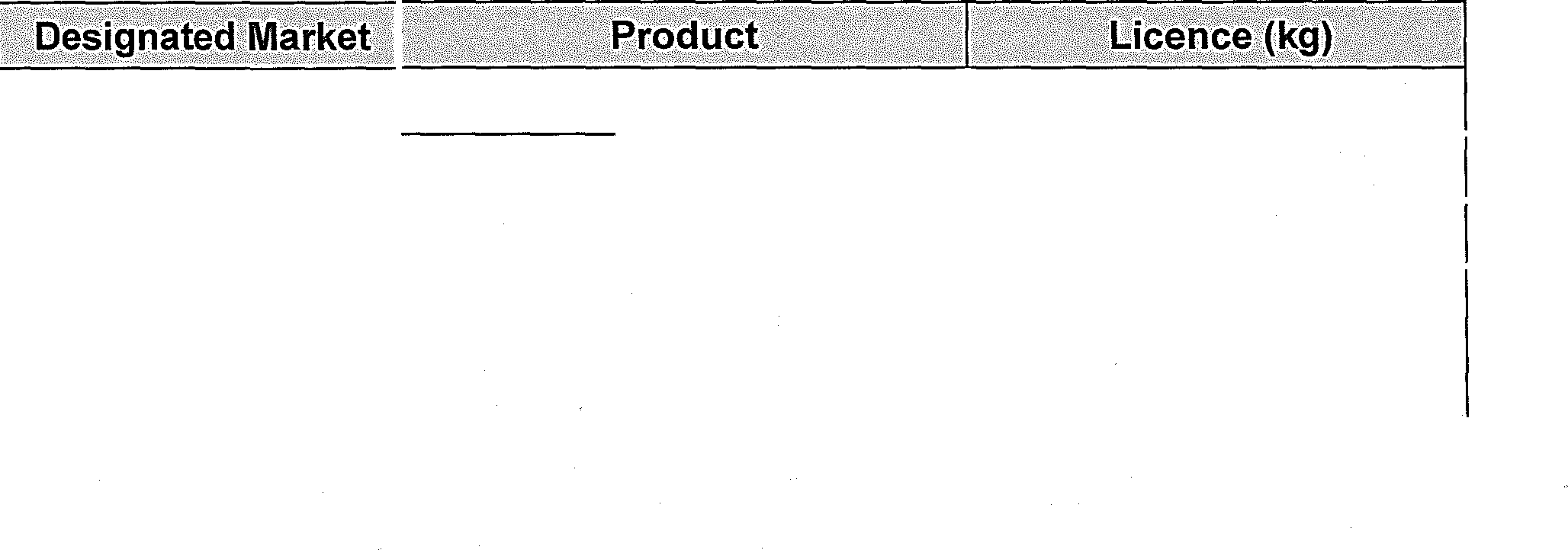
 BRIEF: Talking Points – Pausing the rollout of freshwater farm plans
BRIEF: Talking Points – Pausing the rollout of freshwater farm plans
To:
Hon Todd McClay, Minister of Agriculture
From
Claire McClintock, Manager Water Policy and Adaptive Farming
Date
18 September 2024
MPI Reference
MO24-0454
Priority
Medium
Security Level
In Confidence
Purpose
•
1982
The Cabinet paper:
Pausing the rollout of freshwater farm plans is being lodged before 10:00 am on
Thursday 19 September 2024, for consideration at Cabinet Legislation Committee (LEG) on
26 September, and confirmation by Cabinet on 30 September.
•
This note provides talking points you may wish to use at LEG Committee.
Talking points
Act
•
The Associate Minister for the Environment, Hon Andrew Hoggard, and I see freshwater farm plans
as a key tool in managing freshwater risks moving forward, and are currently exploring ways to
improve the system to make it more practical and cost-effective.
•
Freshwater farm plans are already being rolled out in some regions. Cabinet has agreed to pause this
rollout while improvements are made to the system.
•
Pausing the rollout is time-critical to avoid farmers in Southland and Waikato being required to submit
a freshwater farm plan for certification before changes are made to the system. We do not want any
farmers or growers to be disadvantaged by having to comply with a system that is being changed.
•
Currently, the Resource Management Act 1991 (RMA) does not allow for the Order in Council (which
begins the rollout) to be amended or removed once the rollout has already begun. This is why
Cabinet agreed to make this change by introducing an Amendment Paper to the Resource
Management (Freshwater and Other Matters) Amendment Bill at the Committee of Whole House
stage, likely in late October.
•
The Amendment Paper will amend Part 9A of the RMA and revoke the existing Order in Council. It
Information
will also enable Part 9A to be disapplied by Order in Council in the future.
Official
Page 1 of 1


 Priority
Priority - Low
Security Level - In Confidence
*
New Zealand Food Safety
Ministry for Primary Industries
Manato Ahu Matua
To: Hon Todd McClay, Minister of Agriculture
From: Jenny Bishop, Acting Deputy Director-General New Zealand Food Safety
Dairy Quota Allocations for the 2025 quota year
I
1982
Date I 1 s September 2024
I
Reference
I B24-0446
YES
IZJ /NO □
25 September 2024 Act
Purpose
•
This briefing seeks your agreement to the allocations of export licences for designated
dairy markets for the 2025 quota year.
Background
1.
Country-specific tariff quotas for certain dairy products (dairy quota) are established as
a result of World Trade Organization (WTO) agreements and Free Trade Agreements
(FTA). Dairy quotas are managed by allocating a proportion of the total dairy quota,
with the allocation referred to as an export licence.
2.
Under section 26(3) of the Dairy Industry Restructuring Act (DIRA) 2001, you are
required to make allocations of export licences for designated markets for the
upcoming quota year. The allocation rules are set out in Schedule 5B, specifically:
a) export licences are allocated to eligible participants based on the percentage of
Information
total milk solids collected from dairy farmers in New Zealand in the most recent
season, or the average of the two or three most recent seasons, whichever
results in the highest figure;
b)
to be eligible to receive a share of export licences, participants must collect at
least 0.1 percent of total milk solids collected from dairy farmers in New Zealand;
c)
to apply for an allocation of quota, each participant must submit their milk solids
collection data to the Ministry for Primary Industries' (MPI) Director-General by
statutory declaration;
d)
each eligible participant will only receive an export licence for a particular market
if their share in that market equates to 20 tonnes or more of product. The share
Official
of licences that are less than 20 tonnes will be reallocated pro rata among the
remaining eligible participants;
e)
you must ensure all allocations of export licences are notified in the
New Zealand
Gazette; and
f)
export licences are to be allocated for a period of one quota year. The period that
a quota year covers varies from quota to quota.
Page 1 of 5

1982
Act
Information
Official









B24-0446
8.
EU FTA Tariff Quotas (TQ) export licences to be allocated for the 2025 quota year are
outlined in the table below:
EU
Milk Powders
6,428,000
Butter
6,428,000
Cheese
10,714,000
Dairy Processed Animal
1,556,000
Proteins (PAPs) and High
Protein Whey
1982
9.
Export licences for the EU, UK, US and Dominican Republic are valid from 1 January
2025 to 31 December 2025. Export licences for Japan are valid from 1 April 2025 to
31 March 2026.
Applications
Act
10. On 29 July, MPI contacted dairy companies to apply to participate in the 2025
allocation round of quota to designated markets. The companies contacted were those
who collect over 0.1 percent of the national total of milk solids, and those who are near
the 0.1 percent threshold. As part of their application, companies must submit their
total collection of milk solids from dairy farmers by statutory declaration. Statutory
declarations have been received from four dairy processors.
11. Fonterra Co-operative Group Limited, Open Country Dairy Limited, Synlait Milk
Limited, and Tatua Co-operative Dairy Company Limited have applied for quota
licences in all markets for all products.
12. s 9(2)(b)(ii)
, as all companies
collected over 0.1 percent of total milk solids from dairy farmers in New Zealand in the
most recent dairy season. However, none of these companies chose to apply for the
2025 allocation round. Information
13. MPI has calculated the allocation of export licences, and the results are provided for
your consideration at
Appendix One. Please note, dairy companies are eligible to
transfer any unused allocated quota to other licence holders throughout the quota
year, as outlined in the Dairy Industry Restructuring (Transfer of Export Licences)
Regulations 2009.
14. Exporters who want to use their allocated export licences are required to comply with
the requirements of the Animal Products (Regulated Control Scheme - Dairy Export
Quota Products) Regulations and Notice. Exporters are also required to meet all
appropriate Animal Products Act (APA) 1999 requirements for production, processing
Official
and export.
Page 3 of 5








 824-0446
US quota programmes
824-0446
US quota programmes
15. Exporters who are allocated export licences for the US market are required to advise
MPI of the details of the importer(s) they will use for the importation of product into the
US. MPI is required to notify these details to the US authorities.
16. US authorities assign import licences for the appropriate amount to the designated
importer for the upcoming quota year. These licences are known as designated
importer licences. The communication between MPI and the US authorities, on behalf
of each exporter, must be completed by 30 October 2024. If communication is not
completed by that date, the quota allocated to that exporter becomes ineffective for
the 2025 quota year.
1982
17. US importers can request for unused designated quota to be offered to other countries
(or 'globalised') for the remainder of the quota year. New Zealand licence holders are
consulted on agreeing to these requests. This arrangement does not exist for other
designated markets.
Act
General Export Licence for Dominican Republic and Japan
18. Section 26(5) of the DIRA also authorises you to issue a 'general export licence' for
trade outside the terms of quota (so-called 'over-quota' trade at the normal tariff). This
applies to:
a)
milk powder to the Dominican Republic; and
b)
prepared edible fat to Japan.
19. A general export licence should not be issued until all holders of export licences have
used at least 95 percent of their designated export licences for 'in-quota' trade. s 9(2)
(b)(ii)
20. If in the event this occurs, MPI will work with you to issue general export licences by
way of a notice in the
New Zealand Gazette.
Information
Next Steps
21. The following are attached for your consideration and action:
a)
Appendix One: the proposed allocation of export licences for the 2025 quota
year, calculated in accordance with Schedule 5B of the DIRA;
b)
Appendix Two: letters to participating dairy exporters advising them of their
allocations of export licences for the 2025 quota year (for your signature); and
c)
Appendix Three: a
New Zealand Gazette notice for the allocations of WTO and
TTRQ export licences for the 2024 quota year (for your signature). Once signed,
this will be published in the
New Zealand Gazette.
Official
22. MPI seeks your agreement on these allocations by 20 September 2024, to meet the
deadlines of notifying designated markets of the allocation of export licences for the
upcoming quota year.
Page 4 of 5


B24-0446
Recommendations
23. It is recommended that you:
a)
Note the Dairy Industry Restructuring Act 2001 requires you to allocate export
licenses for dairy products to designated markets;
NOTED
b)
Agree to the allocation of export licenses for designated export markets as
1982
specified at
Appendix One;
YES/ NO
c)
Agree to sign the letters to participating dairy exporters advising them of their
Act
export license allocations for the 2024 quota year, attached at
Appendix Two;
YES/ NO
d)
Agree to sign the notice of these allocations which will be published in the
New
Zealand Gazette at the earliest opportunity, attached at
Appendix Three.
YES/NO
Jenny Bishop
Hon Todd McClay
Acting Deputy Director-General
Minister of Agriculture
Information
New Zealand Food Safety
I "f> I � I 2024
I
I 2024
Official
Page 5 of 5






824-0446
Ann,:inrliv nn,:i• Allnr�+inn T�hloc:, nf l='vnnrf I il'onl'oc:,
.. .
,--...,.-••-••- -••-• • •••---••-•• ■ --■..,....., .., • .._"I"'""'•• .._,v,...,11vv�
1982
Act
Information
Official
Page 1 of 1
Appendix One
Appendix One: Allocation Tables of Export Licences
Export Licences for designated markets under the Dairy Industry Restructuring Act 2001.
Allocations (in kilograms) for the 2025 quota year
Cheese to the European Union under WTO
Fonterra Co-operative Group Limited
5,084,552
The Tatua Co-operative Dairy Company Limited
52,437
Open Country Dairy Limited
603,018
Synlait Milk Limited
290,993
Total Allocated
6,031,000
1982
Butter to the European Union under WTO at 15% MFN
Fonterra Co-operative Group Limited
17,704,461
The Tatua Co-operative Dairy Company Limited
182,586
Act
Open Country Dairy Limited
2,099,713
Synlait Milk Limited
1,013,240
Total Allocated
21,000,000
Butter to the European Union under WTO at 30% MFN
Fonterra Co-operative Group Limited
11,802,973
The Tatua Co-operative Dairy Company Limited
121,724
Open Country Dairy Limited
1,399,809
Synlait Milk Limited
675,494
Total Allocated
14,000,000
Butter to the European Union under WTO at EUR 700 per tonne
Information
Fonterra Co-operative Group Limited
10,266,057
The Tatua Co-operative Dairy Company Limited
105,874
Open Country Dairy Limited
1,217,534
Synlait Milk Limited
587,535
Total Allocated
12,177,000
Milk Powders to the European Union under FTA Tariff Quotas
Fonterra Co-operative Group Limited
5,419,251
Official
The Tatua Co-operative Dairy Company Limited
55,889
Open Country Dairy Limited
642,712
Synlait Milk Limited
310,148
Total Allocated
6,428,000
Page 1 of 4
Appendix One: Allocation Tables of Export Licences
Butter to the European Union under FTA Tariff Quotas
Fonterra Co-operative Group Limited
5,419,251
The Tatua Co-operative Dairy Company Limited
55,889
Open Country Dairy Limited
642,712
Synlait Milk Limited
310,148
Total Allocated
6,428,000
Cheese to the European Union under FTA Tariff Quotas
Fonterra Co-operative Group Limited
9,032,646
1982
The Tatua Co-operative Dairy Company Limited
93,154
Open Country Dairy Limited
1,071,254
Synlait Milk Limited
516,946
Act
Total Allocated
10,714,000
Dairy PAP’s and High Protein Whey to the European Union under FTA Tariff Quotas
Fonterra Co-operative Group Limited
1,323,322
The Tatua Co-operative Dairy Company Limited
nil
Open Country Dairy Limited
156,943
Synlait Milk Limited
75,735
Total Allocated
1,556,000
Butter to the United Kingdom under WTO
Fonterra Co-operative Group Limited
23,197,902
The Tatua Co-operative Dairy Company Limited
239,240
Open Country Dairy Limited
2,751,224
Information
Synlait Milk Limited
1,327,634
Total Allocated
27,516,000
Cheese for Processing to the United Kingdom under WTO
Fonterra Co-operative Group Limited
1,964,353
The Tatua Co-operative Dairy Company Limited
20,258
Open Country Dairy Limited
232,968
Synlait Milk Limited
112,421
Official
Total Allocated
2,330,000
Page 2 of 4
Appendix One: Allocation Tables of Export Licences
Cheddar Cheese to the United Kingdom under WTO
Fonterra Co-operative Group Limited
2,224,860
The Tatua Co-operative Dairy Company Limited
22,945
Open Country Dairy Limited
263,864
Synlait Milk Limited
127,331
Total Allocated
2,639,000
Cheese to the United Kingdom under Transitional Tariff Rate Quotas
1982
Fonterra Co-operative Group Limited
30,350,503
The Tatua Co-operative Dairy Company Limited
313,005
Open Country Dairy Limited
3,599,508
Synlait Milk Limited
1,736,984
Act
Total Allocated
36,000,000
Butter to the United Kingdom under Transitional Tariff Rate Quotas
Fonterra Co-operative Group Limited
9,273,765
The Tatua Co-operative Dairy Company Limited
95,640
Open Country Dairy Limited
1,099,850
Synlait Milk Limited
530,745
Total Allocated
11,000,000
Low Fat Cheese to the United States
Fonterra Co-operative Group Limited
850,464
The Tatua Co-operative Dairy Company Limited
nil
Open Country Dairy Limited
100,863
Information
Synlait Milk Limited
48,673
Total Allocated
1,000,000
Cheddar Cheese to the United States
Fonterra Co-operative Group Limited
4,555,554
The Tatua Co-operative Dairy Company Limited
46,981
Open Country Dairy Limited
540,279
Synlait Milk Limited
260,718
Official
Total Allocated
5,403,532
Page 3 of 4
Appendix One: Allocation Tables of Export Licences
American Type Cheese to the United States
Fonterra Co-operative Group Limited
212,767
The Tatua Co-operative Dairy Company Limited
nil
Open Country Dairy Limited
25,234
Synlait Milk Limited
nil
Total Allocated
238,001
NSPF Cheese to the United States
Fonterra Co-operative Group Limited
5,485,455
1982
The Tatua Co-operative Dairy Company Limited
56,572
Open Country Dairy Limited
650,564
Synlait Milk Limited
313,937
Act
Total Allocated
6,506,528
Milk Powder to the Dominican Republic
Fonterra Co-operative Group Limited
4,046,734
The Tatua Co-operative Dairy Company Limited
41,734
Open Country Dairy Limited
479,934
Synlait Milk Limited
231,598
Total Allocated
4,800,000
Prepared Edible Fat to Japan
Fonterra Co-operative Group Limited
9,737,453
The Tatua Co-operative Dairy Company Limited
100,423
Open Country Dairy Limited
1,154,842
Information
Synlait Milk Limited
557,282
Total Allocated
11,550,000
Notes relating to the allocation tables
1.
Some quantities listed have been rounded up or down to the nearest kilogram.
2.
Companies listed with ‘nil’ have applied for export quota in that specific market but do not
qualify as their share in that market is less than 20 tonnes of product.
Official
Page 4 of 4
B24-0446
Appendix Two: Letters to Dairy Exporters
1982
Act
Information
Official
Page 1 of 1
Appendix Two


B24-0446
Mark de Latour
1982
Chief Executive Officer
Open Country Dairy Limited
PO Box 11 159
AUCKLAND 1542
Act
Dear Mark,
Allocation of quota export licences for 2025
I am pleased to advise you that the allocation round for export licences for the 2025 quota year
has been completed, and that Open Country Dairy Limited has been allocated a share of export
licences. The volume of export licences allocated to each participant is set out in the attached
table.
These allocations have been made under section 26(3) of the Dairy Industry Restructuring Act
2001. This letter is formal notification of these allocations.
Before using these export licences, you should be familiar with any relevant documentation
required by the importing country authorities or New Zealand authorities. This may include:
•
Quota Compliance Programme;
•
Health/sanitary certificate;
Information
•
Country of origin certificate;
•
Dairy quota export authorisation; or
•
IMA (Inward Monitoring Arrangement) certificate and/or a valid import licence.
This list is not exhaustive. For more information regarding the requirements stated above, you
can contact the Ministry for Primary Industries (MPI) Auckland Certification Team at
[email address]. The New Zealand Customs Service can be
contacted for customs-related advice.
Official
Transferring export licences
You may wish to transfer part or all of your export licences to another company. This may only
be done in accordance with the Dairy Industry Restructuring (Transfer of Export Licences)
Regulations 2007. The transferor and the transferee, of all or part of an export licence, must
jointly apply to the Director-General MPI in writing for registration of the transfer. For more
information on transfers, please contact MPI at the above email address.
Warm regards
1982
Hon Todd McClay
Act
Minister of Agriculture
Enc.
Information
Official


B24-0446
Melanie Chong
1982
New Zealand Regulatory Manager
Fonterra Co-operative Group Limited
Fonterra London Street Office
PO Box 459
Hamilton 3210
Act
Dear Melanie,
Allocation of quota export licences for 2025
I am pleased to advise you that the allocation round for export licences for the 2025 quota year
has been completed, and that Fonterra Co-operative Group Limited has been allocated a share
of export licences. The volume of export licences allocated to each participant is set out in the
attached table.
These allocations have been made under section 26(3) of the Dairy Industry Restructuring Act
2001. This letter is formal notification of these allocations.
Before using these export licences, you should be familiar with any relevant documentation
required by the importing country authorities or New Zealand authorities. This may include:
•
Quota Compliance Programme;
•
Health/sanitary certificate; Information
•
Country of origin certificate;
•
Dairy quota export authorisation; or
•
IMA (Inward Monitoring Arrangement) certificate and/or a valid import licence.
This list is not exhaustive. For more information regarding the requirements stated above, you
can contact the Ministry for Primary Industries (MPI) Auckland Certification Team at
[email address]. The New Zealand Customs Service can be
contacted for customs-related advice.
Official
Transferring export licences
You may wish to transfer part or all of your export licences to another company. This may only
be done in accordance with the Dairy Industry Restructuring (Transfer of Export Licences)
Regulations 2007. The transferor and the transferee, of all or part of an export licence, must
jointly apply to the Director-General MPI in writing for registration of the transfer. For more
information on transfers, please contact MPI at the above email address.
Warm regards
1982
Hon Todd McClay
Act
Minister of Agriculture
Enc.
Information
Official


B24-0446
Grant Watson
1982
Chief Executive Officer
Synlait Milk Limited
1028 Heslerton Rd
RD 13
RAKAIA 7783
Act
Dear Grant,
Allocation of quota export licences for 2025
I am pleased to advise you that the allocation round for export licences for the 2025 quota year
has been completed, and that Synlait Milk Limited has been allocated a share of export
licences. The volume of export licences allocated to each participant is set out in the attached
table.
These allocations have been made under section 26(3) of the Dairy Industry Restructuring Act
2001. This letter is formal notification of these allocations.
Before using these export licences, you should be familiar with any relevant documentation
required by the importing country authorities or New Zealand authorities. This may include:
•
Quota Compliance Programme;
•
Health/sanitary certificate; Information
•
Country of origin certificate;
•
Dairy quota export authorisation; or
•
IMA (Inward Monitoring Arrangement) certificate and/or a valid import licence.
This list is not exhaustive. For more information regarding the requirements stated above, you
can contact the Ministry for Primary Industries (MPI) Auckland Certification Team at
[email address]. The New Zealand Customs Service can be
contacted for customs-related advice.
Official
Transferring export licences
You may wish to transfer part or all of your export licences to another company. This may only
be done in accordance with the Dairy Industry Restructuring (Transfer of Export Licences)
Regulations 2007. The transferor and the transferee, of all or part of an export licence, must
jointly apply to the Director-General MPI in writing for registration of the transfer. For more
information on transfers, please contact MPI at the above email address.
Warm regards
1982
Hon Todd McClay
Act
Minister of Agriculture
Enc.
Information
Official


B24-0446
Brendhan Greaney
1982
Chief Executive Officer
The Tatua Co-operative Dairy Company Limited
Private Bag 800
MORRINSVILLE 3340
Dear Brendhan,
Act
Allocation of quota export licences for 2025
I am pleased to advise you that the allocation round for export licences for the 2025 quota
year has been completed, and that The Tatua Co-operative Dairy Company Limited has
been allocated a share of export licences. The volume of export licences allocated to each
participant is set out in the attached table.
These allocations have been made under section 26(3) of the Dairy Industry Restructuring
Act 2001. This letter is formal notification of these allocations.
Before using these export licences, you should be familiar with any relevant
documentation required by the importing country authorities or New Zealand authorities.
This may include:
•
Quota Compliance Programme;
•
Health/sanitary certificate;
•
Information
Country of origin certificate;
•
Dairy quota export authorisation; or
•
IMA (Inward Monitoring Arrangement) certificate and/or a valid import licence.
This list is not exhaustive. For more information regarding the requirements stated above,
you can contact the Ministry for Primary Industries (MPI) Auckland Certification Team at
[email address]. The New Zealand Customs Service
can be contacted for customs-related advice.
Official
Transferring export licences
You may wish to transfer part or all of your export licences to another company. This may
only be done in accordance with the Dairy Industry Restructuring (Transfer of Export
Licences) Regulations 2007. The transferor and the transferee, of all or part of an export
licence, must jointly apply to the Director-General MPI in writing for registration of the
transfer. For more information on transfers, please contact MPI at the above email
address.
1982
Warm regards
Act
Hon Todd McClay
Minister of Agriculture
Enc.
Information
Official
B24-0446
Appendix Three: New Zealand Gazette Notice
With reference to 18(d), this document is publicly available here:
https://gazette.govt.nz/notice/id/2024-go4857
1982
Act
Information
Official
Page 1 of 6
Appendix Three
 Priority
Priority – Low
Security Level – In Confidence
To: Hon Todd McClay, Minister of Agriculture
From: Ed Tregidga, Manager Animal Sector Policy
Meeting with Deer Industry New Zealand
1982
Date 20 September 2024
Reference
AM24-0750
Purpose
•
This aide-memoire provides background information ahead of your meeting with Deer
Act
Industry New Zealand (DINZ).
Context and Background
1. You are meeting with Rhys Griffiths, Chief Executive Officer of DINZ, and Paddy Boyd,
Board Chair, in your office between 1:00 pm to 1:30 pm, on Monday 23 September 2024.
DINZ have provided the following suggested agenda:
a) introductions;
b) update on the deer industry:
i.
recent changes in DINZ management and governance; and
ii.
the situation and outlook for the industry:
(1) a number of farmed deer/trends;
(2) market update; and
Information
(3) other important matters of note;
c) DINZ interaction with the Ministry for Primary Industries (MPI) on:
i.
China velvet market access;
ii.
the approval of the Sustainable Food and Fibre Futures (SFF Futures):
North American Retail Accelerator; and
iii.
wider engagement across DINZ
2. The full meeting agenda is attached as
Appendix One.
Official
AM24-0750
Page 1 of 5
Agenda Item One: Introductions
3. Rhys Griffiths and Paddy Boyd were appointed to their roles in July 2024. This
meeting offers an opportunity for formal introductions between yourself and the
attendees. Biographies of Mr Griffiths and Mr Boyd are attached as
Appendix Two.
Agenda Item Two: Update on the Deer Industry
Recent changes in DINZ management and governance
Chief Executive appointment
4. Rhys Griffiths was appointed as the DINZ Chief Executive Officer in July. He has
worked for DINZ for over 16 years. This includes positions in velvet marketing and
1982
managing the Asian market.
DINZ Board appointments
5. Dr Mandy Bell was a director on the DINZ Board from early July 2021, and was
appointed as DINZ Chair in July 2022. Following a recent appointments process
Act
conducted by the New Zealand Deer Farmers Association (NZDFA), Dr Bell was
unsuccessful in her bid for reappointment as a DINZ director. Her term subsequently
ended on 30 June 2024.
6. Paddy Boyd was appointed to replace Dr Bell in the DINZ Chair role in July 2024. He
has been a director on the DINZ Board since 2023.
s 9(2)(g)(i), s 9(2)(g)(ii)
s 9(2)(a)
s 9(2)(a)
s 9(2)(a)
Situation and outlook for the industry
Information
Deer industry
9. The deer industry is a small but maturing export-focused industry which produces two
main products – venison and velvet. Venison accounts for around 60 per cent of the
value of exports, with velvet making up the remaining 40 per cent.
Venison Exports
10. In 2022/23, venison exports generated approximately $197 mil ion in revenue. In the
year to 30 June 2024, venison export revenue decreased by one per cent to $195 mil ion.
Official
Venison export prices also rose by eight per cent to $15.40 per kilogram, while export
volumes dropped by eight per cent. In the 2024/25 period, venison export revenue is
forecast to increase by nine per cent, with demand potentially exceeding supply.
AM24-0750
Page 2 of 5
11. The United States of America (US) is New Zealand’s largest export market,
accounting for 31 per cent of venison export revenue in the year to 30 June 2024. The
US is followed by China which accounts for 21 per cent of venison export revenue.
12. The European Union (EU) has traditionally been an important market for New Zealand
venison. However, demand from the EU has decreased, with venison export volumes
down 26 per cent in the year to 30 June 2024 compared with the 2022/23 period.
13. The venison industry has also shifted its commercial strategies towards the US and
emerging markets. In the year to 30 June 2024, export revenue to the US increased
by 19 per cent from the previous year.
14. There has been steady overseas demand for venison due to the industry pursuing
new market strategies, new products, and capitalising on premium products, such as
1982
high value cuts.
Velvet exports
15. Velvet is exported both as a wholesale product and as a value-added ingredient for
health food products.
Act
16. In the year to 30 June 2024, velvet export revenue increased by eight per cent, with a
17 per cent lift in export volume from the same period in 2023. This increase was due
to exports to China increasing by 30 per cent in 2023/24 as a result of the change in
importation rules for frozen deer velvet. In addition, demand for velvet in Korea
remains steady, due to a strong consumer preference for high-quality New Zealand
velvet.
17. In 2024/25, sustained demand is forecast to lift both velvet export prices and export
volumes by nine per cent.
18. The industry has been working to develop new markets for New Zealand velvet.
The industry is focusing on three key areas to increase farmgate returns and export
revenue: health food supplements, healthy foods, and traditional medicine. The
Korean health and supplement market in particular offers opportunities for
New Zealand velvet exporters.
Information
Market Update
Deer velvet market access to Taiwan
19. DINZ has identified one of their priorities as improved market access for deer velvet
exports to Taiwan. A particular focus for DINZ is the uncertainty regarding the future
regulation of health food products containing deer velvet. Deer velvet is also
considered to be a Traditional Chinese Medicine (TCM) in Taiwan.
20. s 6(a)
Official
AM24-0750
Page 3 of 5
Venison meat, deer velvet, and deer co-products access into Vietnam
21. s 6(a)
In March 2024,
MPI signed a joint work programme with Vietnam’s Department of Animal Health.
22. This programme includes an in-country systems audit of venison facilities, s 6(a)
This is the last step required by Vietnam for the
reinstatement of New Zealand’s market access for venison.
23. s 6(a)
1982
Deer milk exports to Singapore
24. Industry stakeholders have indicated a strong interest in exporting deer milk to
Singapore. s 9(2)(b)(ii)
Act
25. Deer milk is not approved for import and sale under Singapore’s Sale of Food Act 1973.
The SFA has subsequently requested assistance from New Zealand to support a risk
assessment for deer milk.
26. The SFA is particularly interested in animal health diseases in deer herds and
measures that can be taken to manage diseases. SFA are happy to receive any
science and data, including published veterinary papers from New Zealand to help
inform their risk assessment of deer milk. New Zealand wil also provide information
on transmission of disease via milk and how this is managed.
27. s 9(2)(b)(ii)
Agenda Item Three: DINZ interaction with MPI
28. DINZ wish to convey their appreciation for MPI’s work with deer velvet export access
into China, and the funding approval for the North American (Venison) Retail
Information
Accelerator project. They also wish to provide an update on wider engagement across
the broad functions of DINZ. Further information is provided below.
Clarification of Velvet access into China
29. Historically, New Zealand deer velvet exports to China were subject to TCM
requirements with the majority exported as frozen deer velvet. In October 2023,
General Administration of Customs of the People's Republic of China (GACC) advised
that in future, only dried deer velvet could be exported to China as a TCM. MPI
successfully negotiated with GACC to allow frozen deer velvet exports to continue for
the 2023/24 season, until 30 April 2024.
Official
AM24-0750
Page 4 of 5
30. Since then, MPI has prioritised working with GACC and other Chinese agencies to
agree conditions for continued trade of frozen deer velvet exports to China. This has
included visits to China for technical discussions, and ongoing constructive
negotiations with GACC.
31. Talks have progressed well, and the parties have reached agreement on the text of a
deer velvet arrangement. This wil reinstate an export pathway for frozen deer velvet
exports, which wil be categorised as a product for further processing.
32. MPI is working with GACC on the final steps for trade to commence including
implementation of export certification and the publication of lists of registered
New Zealand processors. MPI remains on track to have market access reinstated
prior to the next velvet export season in November 2024. MPI consulted with DINZ on
the content of the deer velvet arrangement and has provided regular updates to DINZ
1982
throughout this process.
33. s 6(a)
Approval of North American (Venison) Retail Accelerator Project Act
34. On 26 June 2024, in partnership with MPI’s SFF Futures fund, DINZ launched its
North American (Venison) Retail Accelerator Project (the Project).
35. The Project is a three-year collaboration with five venison processing companies:
Al iance Group, Silver Fern Farms, First Light Foods, Duncan NZ Venison, and
Mountain River Venison.
36. SFF Futures has committed $1.414 mil ion funding to the Project, with industry
contributing $3.535 mil ion. The Project is forecasted to deliver an initial $20 million in
revenue for the New Zealand venison industry.
37. The Project aims to:
a) accelerate the development of the North American retail and direct consumer
markets for New Zealand venison; and
b) enable New Zealand producers to connect more closely with US venison
consumers, using retail chains to diversify away from an historic reliance on the
Information
food service sector.
38. A Project Steering Group (PSG) has been established to oversee the Project. The
PSG members include:
a) Scott Champion, Independent Chair;
b) Mark O’Connor, representative for venison exporter companies;
c) Paddy Boyd, DINZ Farmers representative; and
d) Andrew Clark, MPI Investment Manager.
Official
Minister / Minister’s Office
Seen / Referred
/ / 2024
AM24-0750
Page 5 of 5
Appendix One: Meeting Agenda
1982
Act
Information
Official
AM24-0750
Page 1 of 1
Appendix One

Meeting with Minister Todd McClay
Parliament Buildings, Wel ington
1982
23rd September 2024, 1.00pm – 1.30pm
Present: Hon. Todd McClay
Act
Mr Paddy Boyd – Chair Deer Industry New Zealand
Mr Rhys Griffiths – CEO Deer Industry New Zealand
AGENDA
1. Introductions
a. Brief background on Paddy
2. Update on the deer industry
a. Recent changes at governance and management level of DINZ
b. Current situation of the industry
i. Number of farmed deer/trends
Information
ii. Market update
iii. Other important matters of note
3. DINZ interaction with MPI
a. Acknowledgement and appreciation of two recent significant matters
i. China velvet access clarified
ii. Approval of SFFF North American (venison) Retail Accelerator
b. Wider engagement across the broad functions of DINZ
Official

 Appendix Two: Biographies of Attendees
Rhys Griffiths
Chief Executive, Deer Industry New Zealand
(DINZ)
Appendix Two: Biographies of Attendees
Rhys Griffiths
Chief Executive, Deer Industry New Zealand
(DINZ)
Rhys Griffiths was appointed as the Chief
Executive of DINZ in July 2024. Rhys has been
involved with DINZ for the last 17 years: holding
roles such as Velvet Marketing Services
Manager, then becoming the Asia Markets
Manager in 2015.
He has solid relationships with key customers
and a working understanding of venison and
1982
velvet markets.
Previously, Rhys worked in market development
sourcing products for the New Zealand
agricultural sector from Asia. He also worked as
a Marketing Manager for a prominent American
Act
pharmaceutical company.
Paddy Boyd
Chair, DINZ
Paddy Boyd was appointed DINZ Chair in July
2024. Paddy has over four decades of
experience in the deer industry, having owned
his own deer farm since 1997. He has also
managed the Haldon Station in South
Canterbury for the past 42 years.
Paddy has been a DINZ Board member since
2023 and currently sits on the National Velveting
Standards Body. He also serves on the project
steering group for the North American (venison)
Retail Accelerator Programme.
In 2022, Paddy Boyd was awarded the
New Zealand Deer Federation Life Membership
in recognition of his industry knowledge and
Information
contribution.
Official
AM24-0750
Page 1 of 1
Appendix Two
Document Outline











































